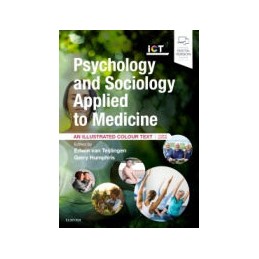- Reduced price

Order to parcel locker

easy pay


 Delivery policy
Delivery policy
Choose Paczkomat Inpost, Orlen Paczka, DHL, DPD or Poczta Polska. Click for more details
 Security policy
Security policy
Pay with a quick bank transfer, payment card or cash on delivery. Click for more details
 Return policy
Return policy
If you are a consumer, you can return the goods within 14 days. Click for more details
Now in its fourth edition, this definitive and popular introduction to human behaviour in the context of health and illness includes three new chapters, many new contributors and a new co-editor.
It is arranged in nine sections to cover the core concepts of psychology and sociology as they apply to medicine.
The life cycle
Development of the person
Society and health
Preventing illness and promoting health
Illness, behaviour and the doctor-patient encounter
Illness and disability
Coping with illness and disability
Hoe do health services work
How do you fit into all this?
Data sheet
1 The life cycle
1 The biopsychosocial model
2 Pregnancy and childbirth
3 Reproductive issues
4 Development in early infancy
5 Childhood and child health
6 Adolescence
7 Social aspects of ageing
8 Bereavement
2 Development of the person
9 Personality and health
10 Understanding learning
11 Perception
12 Emotions
13 Memory problems
14 How does sexuality develop?
15 Intelligence
16 Development of thinking
3 Society and health
17 Understanding groups
18 Concepts of health, illness and disease
19 Measuring health and illness
20 Changing patterns of health and illness
21 Social class and health
22 Gender and health
23 LGBT health
24 Ethnicity and health
25 Quality of life
26 Media and health
27 Housing, homelessness and health
28 Work and health
29 Unemployment and health
30 Labelling and stigma
4 Preventing illness and promoting health
31 Perceptions of risk and risk-taking behaviours
32 What are disease prevention and health promotion?
33 Health screening
34 The social implications of the new genetics
35 Health beliefs, motivation and behaviour
36 Changing cognitions and behaviour
37 Helping people to act on their intentions
38 The social context of behavioural change
39 Illegal drug use
40 Alcohol use
41 Smoking, tobacco control and doctors
42 Eating, body shape and health
5 Illness behaviour and the doctor-patient encounter
43 Deciding to consult
44 Seeing the doctor
45 Placebo and nocebo effects
46 Adherence
47 Clinical communication skills
48 Breaking bad news
49 Self-care
50 Patient experience
51 Psychological preparation for surgery
6 Illness and disability
52 Heart disease
53 Malnutrition and obesity
54 HIV/AIDS
55 Cancer
56 Anxiety
57 Depression
58 Inflammatory bowel disease
59 Physical disability
60 Learning disability
61 Posttraumatic stress disorder (PTSD)
62 Diabetes mellitus
63 Stress and health
64 Asthma and chronic obstructive pulmonary disease
65 Death and dying
7 Coping with illness and disability
66 Counselling
67 Urban nature, health and wellbeing
68 Coping and adaptation
69 Cognitive-behavioural therapy
70 Coping with illness and disability
71 Palliative care
72 Complementary therapies
73 The management of pain
8 How do health services work?
74 Organizing and funding health care
75 Assessing needs
76 Setting priorities and rationing
77 Community care
78 Health: a global perspective
79 Health: a rural perspective
9 How do you fit into all this?
80 Medical students experience
81 Life as a trainee doctor
82 The profession of medicine
References
Index
Reference: 60565
Author: Anne Waugh
Reference: 62847
Author: Melissa Stewart
